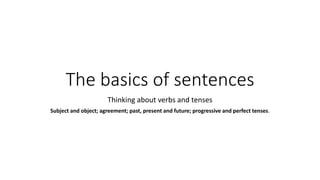The basics of sentences session 6pptx.pptx
•Download as PPTX, PDF•
0 likes•1,594 views
Pie
Report
Share
Report
Share

Recommended
Recommended
More Related Content
Similar to The basics of sentences session 6pptx.pptx
Similar to The basics of sentences session 6pptx.pptx (20)
Recently uploaded
https://app.box.com/s/m9ehjx5owsaox9ykvb9qg3csa8a0jnoxTỔNG HỢP HƠN 100 ĐỀ THI THỬ TỐT NGHIỆP THPT TOÁN 2024 - TỪ CÁC TRƯỜNG, TRƯỜNG...

TỔNG HỢP HƠN 100 ĐỀ THI THỬ TỐT NGHIỆP THPT TOÁN 2024 - TỪ CÁC TRƯỜNG, TRƯỜNG...Nguyen Thanh Tu Collection
https://app.box.com/s/xplac2t6bphx6pe1mofyfj0fvrjx1f3i24 ĐỀ THAM KHẢO KÌ THI TUYỂN SINH VÀO LỚP 10 MÔN TIẾNG ANH SỞ GIÁO DỤC HẢI DƯ...

24 ĐỀ THAM KHẢO KÌ THI TUYỂN SINH VÀO LỚP 10 MÔN TIẾNG ANH SỞ GIÁO DỤC HẢI DƯ...Nguyen Thanh Tu Collection
Recently uploaded (20)
Graduate Outcomes Presentation Slides - English (v3).pptx

Graduate Outcomes Presentation Slides - English (v3).pptx
PSYPACT- Practicing Over State Lines May 2024.pptx

PSYPACT- Practicing Over State Lines May 2024.pptx
How to Send Pro Forma Invoice to Your Customers in Odoo 17

How to Send Pro Forma Invoice to Your Customers in Odoo 17
Basic Civil Engineering notes on Transportation Engineering & Modes of Transport

Basic Civil Engineering notes on Transportation Engineering & Modes of Transport
TỔNG HỢP HƠN 100 ĐỀ THI THỬ TỐT NGHIỆP THPT TOÁN 2024 - TỪ CÁC TRƯỜNG, TRƯỜNG...

TỔNG HỢP HƠN 100 ĐỀ THI THỬ TỐT NGHIỆP THPT TOÁN 2024 - TỪ CÁC TRƯỜNG, TRƯỜNG...
Major project report on Tata Motors and its marketing strategies

Major project report on Tata Motors and its marketing strategies
24 ĐỀ THAM KHẢO KÌ THI TUYỂN SINH VÀO LỚP 10 MÔN TIẾNG ANH SỞ GIÁO DỤC HẢI DƯ...

24 ĐỀ THAM KHẢO KÌ THI TUYỂN SINH VÀO LỚP 10 MÔN TIẾNG ANH SỞ GIÁO DỤC HẢI DƯ...
Trauma-Informed Leadership - Five Practical Principles

Trauma-Informed Leadership - Five Practical Principles
The basics of sentences session 6pptx.pptx
- 1. The basics of sentences Thinking about verbs and tenses Subject and object; agreement; past, present and future; progressive and perfect tenses.
- 2. Subject and verb All sentences have verbs – they are the engine of a sentence. Most have a subject – the ‘do-er’. Bob ate the donut.
- 3. Subject and verb agreement In sentences, the subject and verb have to ‘agree’. The donuts is on the table. The donuts are on the table. Bob eat the donut. Bob eats the donut.
- 4. Subject and verb agreement Singular First person = I Second person = you Third person – she/ he Plural First person = we Second person = you Third person – they ‘I were running’ or ‘I was running’? ‘They was running’ or ‘They were running’?
- 5. Subject Verb Object The subject is the ‘do-er’. The giant The verb provides the action – gets things happening. The giant ate • The object is what is ‘done to’ The giant ate the donut
- 6. Present and Past The present tense is used to show what is happening now. The children listen to the lesson. Past tense is used to show what has already happened. The children listened to the lesson
- 7. Present and Past Most verbs just add ‘ed’ on the end when turned into the past tense: I laugh – I laughed Some change completely: drive – drove eat – ate go – went think – thought speak - spoke
- 8. Future • The future shows what is going to happen. Mostly, use ‘will’: • Tomorrow, I will go to the zoo. • Or another auxillary verb (a little helping verb). The pirates will be sailing tomorrow.
- 9. Progressive • Present progressive shows something is happening: to be (am/are/is) + ’ing’ verb Today, I am running fast. • Past progressive: something was happening: to be (was/were) + ‘ing’ verb Yesterday, I was running slowly.
- 10. Perfect • The perfect tense is used to talk about something that has happened. • Use ‘have’, ‘has’ or ‘had’. • Present perfect: I have eaten my lunch. • Past perfect: I had eaten my lunch.